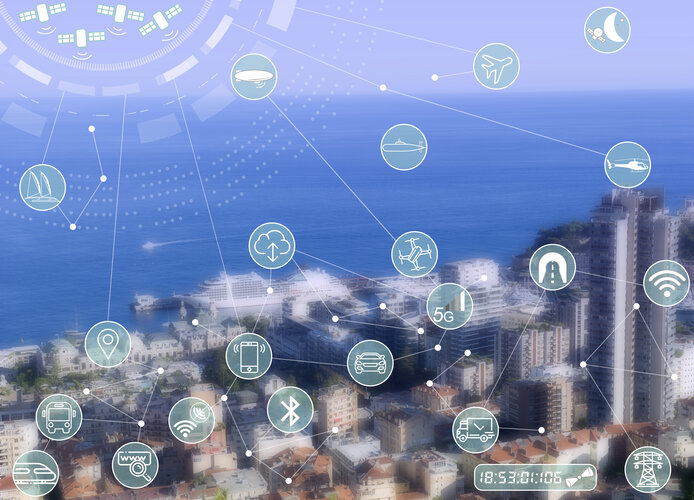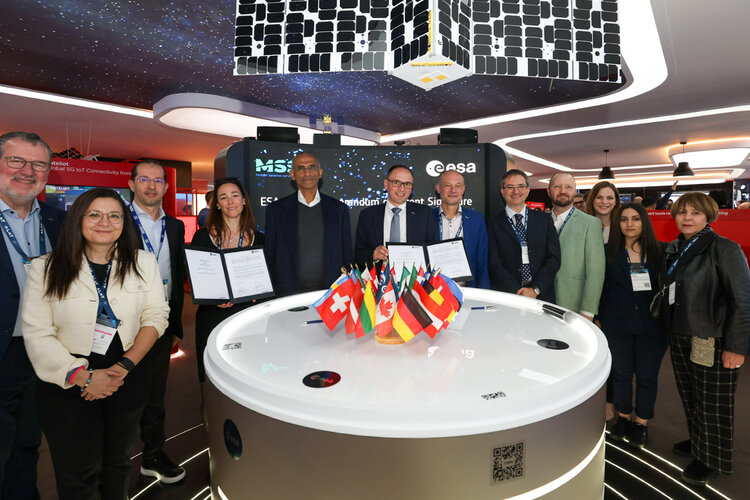
Copernical Team
Call for interest: Biomass launch media event at Europe’s Spaceport in French Guiana

Call for interest
Biomass launch media event at Europe’s Spaceport in French Guiana
ESA signs new chip development for more resilient satnav

It is impossible to imagine our everyday lives – and Europe’s economy – without reliable satellite navigation. Accordingly, ESA prioritises developing and delivering more resilient positioning, navigation and timing technologies and systems into the future. NAVISP Industry Days saw the signing of an industrial contract between ESA and UK’s EnSilica Plc to develop a novel multi-band radio frequency receiver on a single chip, designed to simultaneously receive dual signal streams from all current and future satnav constellations to help overcome interference.
ESA and Mobile Satellite Services Association partner to advance space-based 5G/6G networks

With a new Memorandum of Intent (MoI) signed by the European Space Agency (ESA) and the Mobile Satellite Services Association (MSSA), seamless mobile connectivity that extends everywhere from rural areas to bustling cities has just become closer to reality. The collaboration aims to overcome current coverage limitations by seamlessly combining space and terrestrial systems, helping to close the digital divide across Europe.
Goonhilly Provides Critical Communications for Lunar Mission, Advancing Moon Economy
 Goonhilly Earth Station Ltd continues to play a pivotal role in lunar exploration and infrastructure expansion, reinforcing its importance in humanity's return to the Moon.
Goonhilly is delivering essential communications support for Intuitive Machines' IM-2 mission, which launched on February 27, 2025 (UK time). This marks one of several key lunar missions that Goonhilly will support in 2
Goonhilly Earth Station Ltd continues to play a pivotal role in lunar exploration and infrastructure expansion, reinforcing its importance in humanity's return to the Moon.
Goonhilly is delivering essential communications support for Intuitive Machines' IM-2 mission, which launched on February 27, 2025 (UK time). This marks one of several key lunar missions that Goonhilly will support in 2 Mysterious Icy Objects in Interstellar Space Defy Known Classifications
 The origins of organic molecules-key components of life-remain an open question in astronomy and planetary science. Ice in interstellar environments plays a crucial role in this puzzle, as atoms and molecules accumulate on microscopic dust particles in the frigid, dense regions of space, forming interstellar ices. This process mirrors how snow forms in Earth's clouds.
A team of astronomers
The origins of organic molecules-key components of life-remain an open question in astronomy and planetary science. Ice in interstellar environments plays a crucial role in this puzzle, as atoms and molecules accumulate on microscopic dust particles in the frigid, dense regions of space, forming interstellar ices. This process mirrors how snow forms in Earth's clouds.
A team of astronomers U of A-built instrument reveals pictures of 'baby planets
 With a sun more than 4.5 billion years old, our solar system is considered "middle-aged," and the pictures of what it might have looked like in its infancy are lost to time. Taking advantage of a sophisticated adaptive optics instrument, a team of astronomers at the University of Arizona made observations that reveal unprecedented details of planets when they are very young.
The instrument
With a sun more than 4.5 billion years old, our solar system is considered "middle-aged," and the pictures of what it might have looked like in its infancy are lost to time. Taking advantage of a sophisticated adaptive optics instrument, a team of astronomers at the University of Arizona made observations that reveal unprecedented details of planets when they are very young.
The instrument James Webb Telescope reveals planet-forming disks can last longer than previously thought
 If there were such a thing as a photo album of the universe, it might include snapshots of pancake-like disks of gas and dust, swirling around newly formed stars across the Milky Way. Known as planet-forming disks, they are believed to be a short-lived feature around most, if not all, young stars, providing the raw materials for planets to form.
Most of these planetary nurseries are short-
If there were such a thing as a photo album of the universe, it might include snapshots of pancake-like disks of gas and dust, swirling around newly formed stars across the Milky Way. Known as planet-forming disks, they are believed to be a short-lived feature around most, if not all, young stars, providing the raw materials for planets to form.
Most of these planetary nurseries are short- Japan puts world's most accurate clock on sale for $3.3 mn
 Resembling a squat, wide fridge, the world's most accurate clock went on sale for $3.3 million in Japan on Wednesday.
The "Aether clock OC 020" is so precise that it would take 10 billion years for it to deviate by one second, according to its Kyoto-based manufacturer Shimadzu Corp.
Known as a "strontium optical lattice clock", it is 100 times more accurate than caesium atomic clocks, th
Resembling a squat, wide fridge, the world's most accurate clock went on sale for $3.3 million in Japan on Wednesday.
The "Aether clock OC 020" is so precise that it would take 10 billion years for it to deviate by one second, according to its Kyoto-based manufacturer Shimadzu Corp.
Known as a "strontium optical lattice clock", it is 100 times more accurate than caesium atomic clocks, th Beyond our solar system scientists uncover potential new exoplanet
 Researchers from UNSW Sydney have identified a possible new exoplanet-an extrasolar planet-through an approach called transit timing variation (TTV). This technique enabled them to detect subtle shifts in the orbital timing of a known planet, hinting at the presence of another planetary body.
Published in The Astrophysical Journal, the study, led by Scientia Senior Lecturer Ben Montet and
Researchers from UNSW Sydney have identified a possible new exoplanet-an extrasolar planet-through an approach called transit timing variation (TTV). This technique enabled them to detect subtle shifts in the orbital timing of a known planet, hinting at the presence of another planetary body.
Published in The Astrophysical Journal, the study, led by Scientia Senior Lecturer Ben Montet and Gravity from Entropy A Radical New Framework for Quantum Gravity
 A groundbreaking study published in Physical Review D by Professor Ginestra Bianconi of Queen Mary University of London introduces a revolutionary approach to understanding gravity through quantum relative entropy. This innovative framework seeks to bridge the gap between quantum mechanics and Einstein's general relativity-two fundamental but historically incompatible theories in physics.
A groundbreaking study published in Physical Review D by Professor Ginestra Bianconi of Queen Mary University of London introduces a revolutionary approach to understanding gravity through quantum relative entropy. This innovative framework seeks to bridge the gap between quantum mechanics and Einstein's general relativity-two fundamental but historically incompatible theories in physics. 
